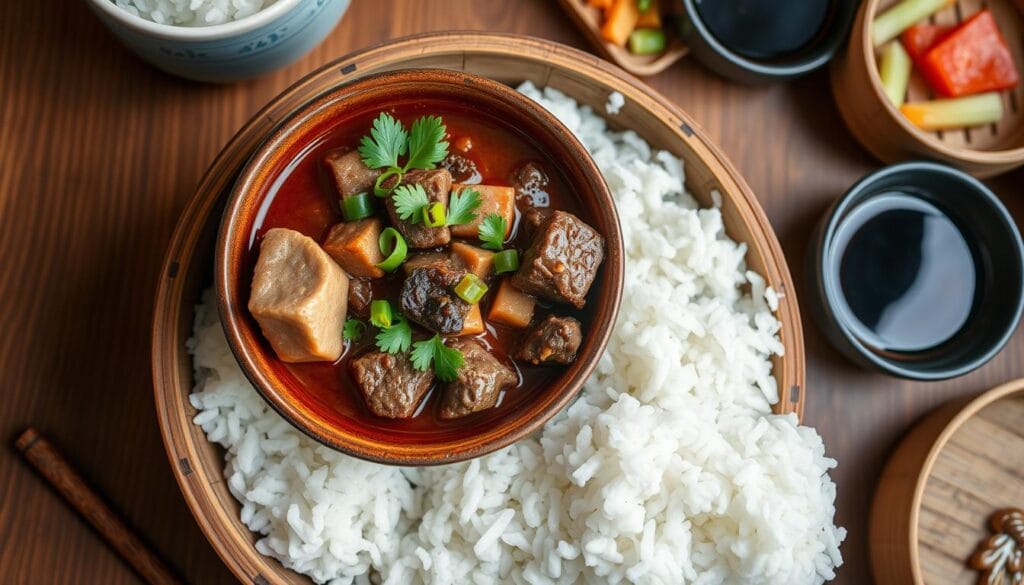On a chilly winter evening, the smell of simmering beef stew roux fills my kitchen. It reminds me of my grandmother’s cozy Tokyo apartment. The rich, warming flavors of dashi broth and tender wagyu beef are more than just food. They connect me to my culinary roots.
Japanese beef stew is an art that turns simple ingredients into a comforting dish. Whether you’re a home cook or a culinary enthusiast, learning to make the perfect roux can improve your cooking. It brings authentic Japanese flavors to your table.
Table of Contents
What is Japanese Beef Stew Roux?
Japanese cuisine is known for turning simple ingredients into amazing dishes. At the center of many favorite recipes is the magical beef stew roux. It’s a concentrated flavor that makes home cooking taste like it’s from a restaurant.
The roux is a secret ingredient in Japanese kitchens. It makes stews rich and flavorful, warming both body and soul. By mixing ingredients like mirepoix, katsuobushi, and shio koji, home cooks can create complex flavors.
Understanding the Culinary Foundation
A traditional beef stew roux has:
- Flour to thicken
- Cooking oil or butter
- Blended spices
- Umami-rich ingredients
Purpose in Japanese Home Cooking
The main role of beef stew roux is more than thickening. It’s a flavor conductor, blending ingredients into a perfect dish. Adding shio koji brings depth and complexity, making your stew taste like a pro chef’s.
“A great roux is the difference between a good stew and an unforgettable meal.”
Japanese home cooks love roux for its ease and ability to elevate simple ingredients. It lets even beginners make meals that taste like they’re from a restaurant.
Key Ingredients for Beef Stew Roux
Making a real Japanese beef stew needs the right ingredients. They add depth and flavor to your dish. Knowing what to use can make your cooking stand out.
Essential Ingredients for the Perfect Roux
The base of a tasty beef stew roux includes a few key items. You’ll need:
- Flour for thickening
- Beef suet for rich flavor
- Curry powder
- Tomato paste
- Garam masala
Flavor-Enhancing Optional Add-Ins
To make your beef stew even better, try these optional ingredients:
- Finely chopped negi (Japanese green onions)
- Minced garlic
- Fresh ginger
- Red wine for depth
- Soy sauce
“The secret to an exceptional Japanese beef stew lies in the quality and balance of its ingredients.”
The roux you choose can really change the taste. Brands like S&B Golden Curry make it easy for home cooks to get authentic flavors.
Protein and Vegetable Selections
| Protein | Recommended Cuts |
|---|---|
| Beef | Chuck roast, sirloin |
| Alternative Proteins | Chicken, plant-based options |
For a true Japanese stew, add traditional veggies like potatoes, carrots, and onions. Each adds to a dish that’s both memorable and full of flavor, capturing the heart of Japanese comfort food.
Step-by-Step Guide to Making the Roux
Making the perfect beef stew roux japanese style needs care and detail. The roux turns a simple stew into a rich, tasty dish. It will make your taste buds happy.
Learning to make the beef stew roux starts with knowing the basics. We’ll take it one step at a time:
Crafting the Perfect Roux Base
- Begin with equal parts fat (butter or oil) and flour
- Use a heavy-bottomed pan for even heat
- Cook the mix over medium-low heat
When making your dashi broth-infused roux, aim for a smooth, golden color. The color shows the flavor’s depth. Lighter roux tastes mild, while darker roux is more intense.
Incorporating Flavor Elements
Make your beef stew roux better by adding special seasonings. Here are some tips:
- Add minced garlic and ginger for a strong aroma
- Use Japanese curry powder for a true taste
- Try dashi broth to add more umami
| Roux Consistency | Tablespoons per Quart | Sauce Thickness |
|---|---|---|
| Thin | 6 tablespoons | Light sauce |
| Medium | 8 tablespoons | Standard thickness |
| Thick | 10 tablespoons | Heavy gravy |
“The secret to an exceptional roux lies in patience and constant stirring.” – Japanese Culinary Tradition
Remember, making the perfect beef stew roux japanese style takes time. Every try gets you closer to being a pro. Soon, you’ll turn a simple stew into a special meal.
Tips for Perfecting Your Roux
Making the perfect roux for your Japanese beef stew needs precision and patience. Whether you’re using wagyu beef or a traditional cut, mastering the roux technique can boost your cooking skills.
Getting the right consistency is key for a delicious stew. It’s all about the balance of ingredients and cooking methods.
Achieving the Perfect Roux Consistency
- Start with a low to medium heat setting
- Stir constantly to prevent burning
- Use high-quality ingredients like mirepoix for depth of flavor
- Aim for a smooth, lump-free texture
When making your roux, watch the color and smell. A good roux smells nutty and turns golden-brown. Add katsuobushi for an extra umami kick that will make your stew stand out.
Common Mistakes to Avoid
| Mistake | Consequence | Solution |
|---|---|---|
| Adding roux to cold liquid | Lumpy texture | Ensure liquid is hot before incorporating |
| Overcooking the roux | Bitter taste | Monitor heat and cooking time carefully |
| Inconsistent stirring | Uneven cooking | Stir continuously and evenly |
“Patience is the secret ingredient in creating the perfect roux. Take your time and let the flavors develop naturally.” – Japanese Culinary Expert
Remember, practice makes perfect. Each time you make your roux, you’ll get better. Don’t worry if it takes a few tries – even pros started somewhere.
Choosing the Right Cuts of Beef
Choosing the perfect beef cut is key to a delicious Japanese stew. The right meat can turn a simple meal into a memorable experience. It’s all about the meat.
For a traditional Japanese stew, some beef cuts are better than others. The fat and muscle structure make the meat tender and full of flavor. It’s like a taste explosion in your mouth.
Prime Beef Cuts for Stewing
- Chuck Roast: Ideal for slow cooking, with rich marbling and deep flavor
- Beef Brisket: Provides exceptional tenderness when braised
- Sirloin: Offers a balance of lean meat and fat content
Preparing Your Beef for Cooking
To get the best flavor and texture, follow these steps. Use beef suet to add richness to your stew. Cut your meat into 1-inch cubes for even cooking. A bit of shio koji can tenderize the meat and add a unique umami taste.
“The secret to a perfect Japanese beef stew lies in selecting the right cut and preparing it with care.”
Pro Tips for Beef Selection
- Choose cuts with good marbling for maximum flavor
- Trim excess fat, but leave some for richness
- Consider using a meat tenderizer for extra softness
- Avoid extremely lean cuts that can become tough
The right beef cut can make your stew amazing. Spend time picking and preparing your meat. You’ll make a Japanese beef stew that will wow everyone.
Cooking Techniques for Beef Stew
Making the perfect beef stew needs you to know some cooking tricks. These tricks help bring out the flavors of your dish. Learning these methods can turn a simple meal into a feast.
Optimal Cooking Methods for Tender Beef
There are several ways to cook your beef stew, each with its own benefits. Here are the main methods to think about:
- Stovetop Method: Great for deep flavors
- Slow Cooker Technique: Easy for those who don’t want to cook
- Pressure Cooker Approach: Cooks fast

Temperature and Time Considerations
Getting your beef stew just right means watching the temperature and cooking time. When making your stew with negi and beef, remember these important points:
| Cooking Method | Temperature | Cooking Time |
|---|---|---|
| Stovetop | Low-Medium Heat | 2-3 Hours |
| Slow Cooker | Low Setting | 6-8 Hours |
| Pressure Cooker | High Pressure | 30-45 Minutes |
Pro Tip: Make sure your beef is at least 145°F (63°C) for safety and tenderness.
“The secret to a perfect beef stew lies in patience and precise temperature control.” – Culinary Experts
Remember, slow simmering is crucial for tender meat and rich flavors. Try different methods to find your favorite way to make a delicious beef stew. It will surely impress your loved ones.
Complementary Ingredients for Stew
Making a great Japanese beef stew means picking the right ingredients. These choices can turn a simple dish into a memorable meal. It’s all about how each part works together.
Root Vegetables: Nutritional Powerhouses
Root vegetables add depth and texture to your stew. Here are some key ones:
- Potatoes: They thicken the stew and add a creamy feel.
- Carrots: They bring sweetness and a bright color.
- Onions: They form the base of the flavor.
- Sweet potatoes: They add a rich sweetness.
Seasoning for Authentic Flavor
Seasoning is key to making your stew stand out. Dashi broth is a great choice. It adds a deep umami flavor.
| Ingredient | Flavor Profile | Recommended Quantity |
|---|---|---|
| Dashi Broth | Umami-rich | 1 cup |
| Mirepoix | Aromatic base | 1/2 cup |
| Ginger | Spicy warmth | 1 tablespoon |
| Soy Sauce | Salty depth | 2 tablespoons |
Choosing and balancing these ingredients will make your Japanese beef stew amazing. It will please your taste buds and honor traditional cooking.
Serving Suggestions
Presenting your Japanese beef stew is an art. It’s more than just filling a bowl. The right way to serve it can make your meal unforgettable. It adds a special touch with thoughtful pairings and garnishes.

Perfect Pairings to Complement Your Stew
Your beef stew needs great friends. Here are some side dishes that will make the flavors pop:
- Steamed white rice – the classic choice
- Crusty artisan bread for dipping in the sauce
- Quick pickled vegetables with shio koji for a tangy twist
- Miso soup to balance the meal’s richness
Presentation Tips for a Stunning Dish
Make your plate look amazing. Sprinkle katsuobushi flakes on top for a burst of umami. Choose deep, wide bowls to show off the stew’s rich flavors.
“A feast for the eyes is a feast for the soul” – Japanese Culinary Proverb
Decorate with fresh herbs like green onions or cilantro. Their bright green will pop against the stew’s dark color.
Serving Pro Tips
- Warm your serving dishes before serving to keep the stew hot
- Use a ladle for a neat, controlled pour
- Offer small side condiments for a personal touch
Storing and Reheating Leftovers
Your beef stew roux Japanese dish needs good storage to keep its flavors. Let the stew cool down at room temperature before putting it in airtight containers. This way, your stew can stay fresh in the fridge for 3-4 days, giving you more meals.
Freezing is great for keeping it longer. Divide the stew into parts, leaving some room at the top. Your beef stew can be frozen for up to 3 months. Try adding chopped negi on top before reheating for a fresh taste.
Reheating should be done carefully to keep the stew’s texture and taste. Heat it on low on the stovetop, stirring now and then. If it’s too thick, add some beef stock. Microwave users, heat in short bursts, mixing each time. Good reheating is key to keeping the flavor and texture right.
Preservation Techniques
Choose glass or top-quality plastic containers with tight lids for storing your stew. Mark the containers with the date you made it. Always use clean tools when serving to keep it fresh longer.
FAQ
What is Japanese beef stew roux?
What are the best cuts of beef for Japanese beef stew?
How do I make the perfect roux for beef stew?
What vegetables work best in Japanese beef stew?
How should I serve Japanese beef stew?
How do I store and reheat leftover beef stew?
What cooking methods can I use for Japanese beef stew?
There are no reviews yet. Be the first one to write one.

